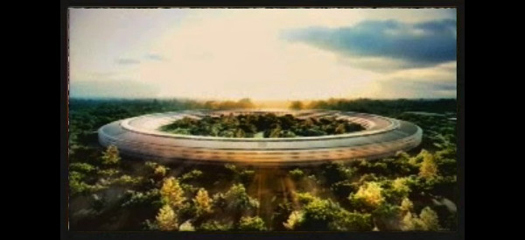
On Tuesday, Steve Jobs unveiled Apple's latest seamless, white, glowing product before the Cupertino City Council: the company's proposed new headquarters, a four-story, glass-walled circular building intended to house 12,000 employees. "It's a little like a spaceship landed," Jobs said. And the blurry, sunstruck renderings (architect pointedly unspecified) did indeed remind me of early Spielberg.
But after marveling at the idea of an endless corridor of offices, and speculating on Twitter about which firm could handle all that curved glass, I realized Apple's ring reminded me of something else. And it wasn't the future. It was 1957.

That was the year Skidmore, Owings & Merrill completed the Connecticut General Life Insurance Headquarters in Bloomfield, a suburb of Hartford. Sure, it is a box rather than a ring, but the concept is strikingly similar: an inward-looking, hermetic, heterotopic corporate world. An architecturally distinguished, technologically advanced retreat from the city, one complete wnough to include its own grounds, its own restaurant, its own artworks, its own store, its own bowling alley, and its own clubs. Employees weaned from urban life by recreating its social qualities outside the city. But obviously, for employees only.
Foster + Partners (the name most frequently suggested for the plans) seems like today's equivalent of SOM in the 1950s. Connecticut General had endless modular grids, Apple will have an endless spiral. Both transfer urban paradigms (Lever House, the Gherkin) to a suburban setting. Both use the latest building and communications technology. Jobs could do worse than to choose the contemporary equivalent of Isamu Noguchi, who designed the courtyards, to provide some corporate art. Noguchi did courtyards for one of SOM's own knock-offs of this plan, for IBM, expansionist in the 1960s, in Armonk. Another knock off, this time by John Bolles, is the founding building of Silicon Valley: IBM's Building 25 in San Jose.

Wouldn't it have been more radical for Apple to double down on an actual town? To act more like J. Irwin Miller in Columbus than CG chairman Frazar Wilde in Bloomfield. Miller hired Alexander Girard to spiff up Main Street, and masterminded adaptive reuse of the old storefronts to provide his employees and his neighbors what they needed in town. Cupertino leaders fell all over themselves in their desire to keep Apple's taxes in town, but wouldn't it be better to benefit from some of its knowledge and physical assets?
As Alissa Walker asked on Gelatobaby:
Is Apple going to make the grounds open to the public so they can enjoy the fifty billion trees that he’ll be planting? Will there be any kind of programming in the new auditorium that can expose the next generation to careers in technology and science? Could you share your awesome private transit system with the public? Would you be willing to help us with our own energy issues by teaching us how you’re making your own renewable power plant?A recent New Yorker profile of John Lasseter and Pixar, once owned by Jobs, emphasized the importance for their corporate culture of chance encounters. But in these corporate motherships, and on these corporate campuses, those chance encounters are only employee to employee. What about chance encounters with the rest of the world? Apple's employees are already in a number of existing Cupertino buildings, and Jobs indicated the room for 12,000 in the ring would not be enough. A) This sounds like they are about to willfully create second-class citizens outside the ring and B) couldn't strategic architectural insertions, renovations, reuses be made in Cupertino or some other town so that Apple employess might still dwell among us?
The intent at Connecticut General was utopian. When it opened, civic leaders converged on the building as if it might provide the key to America's growing pains. And if it had been a one- or two-off it might have been OK. But the all-in-one model was too tempting, and corporations fleeing cities to their own boxes-on-stilts-on-100-acres emptied out downtowns. Finally, companies have realized it is in their interests to stay in the city. Why is Apple thinking different?
